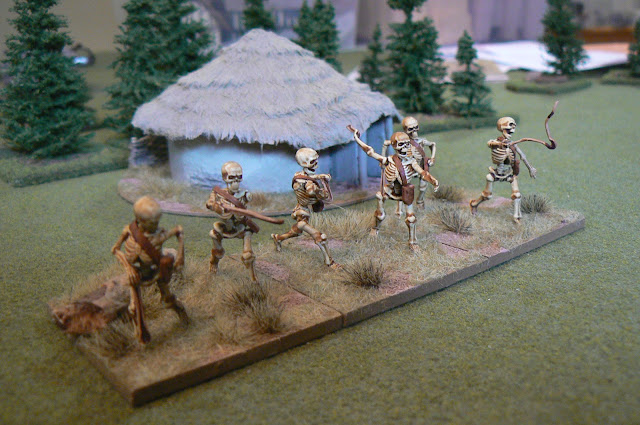Battle of El Itwil’do
somewhere in the Sinai, 1917
You are Captain Angus Young of the Queensland Fusiliers and you are deep in it.
Your commanding officer a pommie bastard named Sir David Evans wants more glory; at your expense. So he has ordered your unit to make an attack to take the well in the village of El Something-or-another thereby securing a forward supply of water for the upcoming campaign against Gaza and securing him the laurels of the damned uppy-de-ups.
He has you standing at attention in his tent.
“Captain Young”, he says in his high-pitched voice, “to continue our glorious advance against the Muslim hordes we are required to take the well and supply water for the troops, what. I have come up with a brilliant plan, I might add.”
Oh crickey, you think, now we are really in trouble!
Sir David continues, “We will do something the Turks and their German masters will not expect…a night attack. BY your expression, Young, I see it has surprised you also”
Surprised? You idiot!, your inner voice screams, night attacks are more trouble than…
Your train of thought is interrupted by his statement, “the attack shall not commence with the usual artillery as that will merely wake them up, what?”
No artillery?!”, you blurt out.
“No, Young, but we have a further surprise for the Turks”.
“Water pistols, sir?” you surmise.
“Water pistols? My good man, won’t do at all. They would not be effective without the water obtained at the wells. Not very militarily astute you Aussies, I see.”, he replies.
You merely wait.
“My ace card,” Sir David elaborates, “is the use of two tanks my cousin ‘obtained’ on route here. God knows where he got them from, but our gain, what?”
You finally zone out of his further comments. two tanks blindly going around in the dark. All the while your boys must attack, without artillery support, going against no doubt heavily guarded positions we have had no time to reconnoiter and under the command of this moron..
“Right. Attack starts at 04:00. Sir David says decisively hammering his pen upon his table. Dismissed”
It is 06:00, the sun is well up but orders were given at 04:00 to wait for the tanks. You have had the troops resting in the meantime. You restarting to think that perhaps Evans does have some notion that the moment has well passed omitting to tell you to stand down, while he formulated another of his clever plans.
You then hear the clank and rumble of heavy engines. The tanks are here.
As you stare at the iron monsters, an adjutant rides up primly to your station.
“Right, Young, your supports are here, you may begin your attack,” stated the waxed moustached officer.
You are dumfounded, but your inner voice calmly acknowledges that you were dreaming to think that daylight should interfere with Sir David bleeping Evans’ wishes.
“Well,” the mounted officer demands, “get on with it”
 |
| The Aussie assault with the tanks in support (the upper one already suffering 1 strength loss. |
.......
Meanwhile in the village of El Itwil'do in the Sinai, 1917
You are Col. Ahmet Bazak, commander of the 32nd Osman Infantry Battalion defending the well at El Itwil’do. You have four companies of riflemen, a battery of artillery and full contingent of machine guns. Col. Schmilman, your German advisor fears it will not be enough.
But it is in the hands of Allah and so you must do with what you have.
 |
| The Turks in their trenches with artillery in support. |
GM notes:
Col. Bazak, you can have your troops dig trenches throughout the previous night but this will cause fatigue so will reduce their courage by two (from 5+ to 7+) but offers Armour 3 than 2. [Players of Dragon Rampant will recognize my use of that rule set as the basis for this WW1 campaign].
You have yourself as encouragement for the troops (one stand of command to attach at any start of your turn to any unit to offer a one-time re-roll of any courage test.) If successful, you can move the stand to another unit. If failure, the stand is removed.
Col. Schilman offers a one-time re-roll of any activation dice for the artillery.
 |
| The Australian LMG company leapfrogs the infantry to continue the advance. |
With Peter playing the part of Young and commander of the Aussies, he selected four companies of infantry, and the LMG company to accompany the tanks in the assault.
Craig did indeed have his Turkish infantry dig trenches for themselves in front of the village and its water well. While the players did not know it, the troop points were even at 30 each, with the tanks adding 20 points to the Aussie total in the attack.
[Note: Tanks were indeed sent to the Sinai and used in the Battles for Gaza, but had limited success and many were destroyed by Turkish artillery; the rest withdrawn back to the Western Front shortly thereafter]
While the Aussie assault ultimately failed, Peter was pleased with the ‘even-ness’ of the scenario and with different dice, the outcome might have been different.
Much discussion of the upcoming campaign was made. So further battles will occur as the Aussies thrust toward Gaza.























































